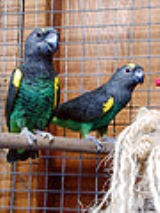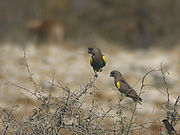
Meyer's Parrot
Encyclopedia
The Meyer's Parrot is a small (about 21 cm, 90-130g), stocky African parrot
. Meyer's parrots display a dull brown head, back and tail, green or blue-green abdomen, blue rump and bright yellow markings on the carpal joint of the wings. Most subspecies have some yellow on the top of the head as well. Forshaw (1989) recognizes six subspecies of P. meyeri which vary in home range, size and in markings, including the extent of yellow markings on the head and wings and intensity of turquoise markings on the abdomen and rump. The name commemorates the German ornithologist Bernhard Meyer
.
The western races P. m. damarensis and P. m. reichenowi lack yellow markings on the head. Belly and rump colours vary according to race from turquoise or blue to green.
where they occur in several woodland types including miombo
, savanna
woodlands, wooded grasslands and forests bordering watercourses or agricultural land. They are found in high densities in the Okavango Delta
region of Botswana.
 Meyer's Parrots are still common in the wild, although numbers have decreased locally following destruction of woodlands. The IUCN Red List classifies the Meyer's parrot as Low Risk/Least Concern. The large population, limited pressure from trade and hunting and 6,000,000 km² home range of the species make these birds unlikely to face extinction in the near future. The trade in Meyer's Parrots that have been bred in aviculture is legal. Meyer's Parrots are listed on Appendix II of the Convention on International Trade in Endangered Species of Wild Flora and Fauna. Appendix II listing means the species can also be taken from the wild and traded in 'limited' numbers.
Meyer's Parrots are still common in the wild, although numbers have decreased locally following destruction of woodlands. The IUCN Red List classifies the Meyer's parrot as Low Risk/Least Concern. The large population, limited pressure from trade and hunting and 6,000,000 km² home range of the species make these birds unlikely to face extinction in the near future. The trade in Meyer's Parrots that have been bred in aviculture is legal. Meyer's Parrots are listed on Appendix II of the Convention on International Trade in Endangered Species of Wild Flora and Fauna. Appendix II listing means the species can also be taken from the wild and traded in 'limited' numbers.
Parrot
Parrots, also known as psittacines , are birds of the roughly 372 species in 86 genera that make up the order Psittaciformes, found in most tropical and subtropical regions. The order is subdivided into three families: the Psittacidae , the Cacatuidae and the Strigopidae...
. Meyer's parrots display a dull brown head, back and tail, green or blue-green abdomen, blue rump and bright yellow markings on the carpal joint of the wings. Most subspecies have some yellow on the top of the head as well. Forshaw (1989) recognizes six subspecies of P. meyeri which vary in home range, size and in markings, including the extent of yellow markings on the head and wings and intensity of turquoise markings on the abdomen and rump. The name commemorates the German ornithologist Bernhard Meyer
Bernhard Meyer
Dr Bernhard Meyer was a German physician and naturalist.Meyer was the joint author, with Philipp Gottfried Gaertner and Johannes Scherbius of Oekonomisch-technische Flora der Wetterau , which was the source of the scientific name of many plants...
.
Taxonomy
The six subspecies are:- P. m. meyeri (CretzschmarPhilipp Jakob CretzschmarPhilipp Jakob Cretzschmar was a German physician.Cretzschmar was born at Sulzbach and studied medicine at the University of Würzburg. He taught anatomy and zoology at the Senckenberg Medical Institute of Frankfurt....
, 1827) — s Chad to w Ethiopia - P. m. saturatus (SharpeRichard Bowdler SharpeRichard Bowdler Sharpe was an English zoologist.-Biography:Sharpe was born in London and studied at Brighton College, The King's School, Peterborough and Loughborough Grammar School. At the age of sixteen he went to work for Smith & Sons in London...
, 1901) — Uganda and w Kenya to w Tanzania - P. m. matschiei (NeumannOscar Rudolph NeumannOscar Rudolph Neumann was a German ornithologist.Neumann travelled to Africa on several occasions, in particular between 1892 and 1894, and described many new African species...
, 1898) — c Tanzania, se Congo, Zambia and n Malawi - P. m. reichenowi (Neumann, 1898) — c Angola to s Congo
- P. m. damarensis (Neumann, 1898) — n Namibia, s Angola and nw Botswana
- P. m. transvaalensis (Neumann, 1899) — Botswana, Zimbabwe and n South Africa
The western races P. m. damarensis and P. m. reichenowi lack yellow markings on the head. Belly and rump colours vary according to race from turquoise or blue to green.
Range and habitat
Meyer's parrots are native to the plateau woodlands of sub-Saharan AfricaAfrica
Africa is the world's second largest and second most populous continent, after Asia. At about 30.2 million km² including adjacent islands, it covers 6% of the Earth's total surface area and 20.4% of the total land area...
where they occur in several woodland types including miombo
Miombo
Miombo is the Swahili word for Brachystegia, a genus of tree comprising a large number of species. Miombo woodland is classified in the tropical and subtropical grasslands, savannas, and shrublands biome...
, savanna
Savanna
A savanna, or savannah, is a grassland ecosystem characterized by the trees being sufficiently small or widely spaced so that the canopy does not close. The open canopy allows sufficient light to reach the ground to support an unbroken herbaceous layer consisting primarily of C4 grasses.Some...
woodlands, wooded grasslands and forests bordering watercourses or agricultural land. They are found in high densities in the Okavango Delta
Okavango Delta
The Okavango Delta , in Botswana, is the world's largest inland delta. It is formed where the Okavango River empties onto a swamp in an endorheic basin in the Kalahari Desert, where most of the water is lost to evaporation and transpiration instead of draining into the sea...
region of Botswana.
Food and feeding
Their wild diet includes fruits, seeds, nuts, berries and cultivated crops. Seeds of the various leguminous trees of the African woodlands are especially favoured, providing their staple food in some areas. Although they normally travel in pairs or small flocks, wild Meyer's Parrots may gather in much larger numbers where food is plentiful. In drought years they wander in search of food.Breeding
The Meyer's parrot nests in tree cavities. The eggs are white and there are usually three or four in a clutch. The female incubates the eggs for about 28 days and the chicks leave the nest about 60 days after hatching.Conservation status


